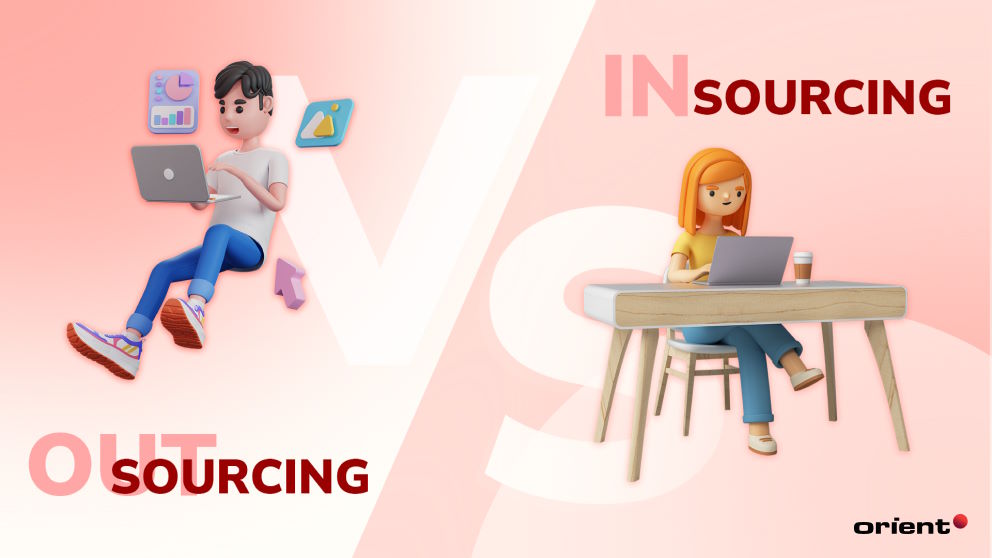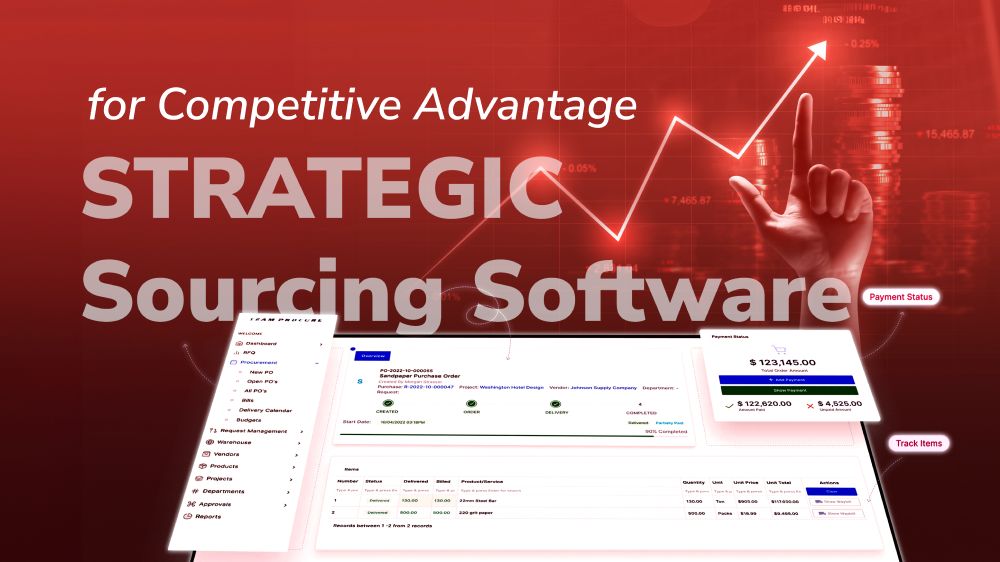Insourcing vs. Outsourcing: Differences & Pros and Cons of Each Strategy

Content Map
More chaptersIn such a globalized market as today, organizations advantageously have several ways to manage their business processes; outsourcing and insourcing are two common practices among them. Perhaps we are no longer strangers to outsourcing, especially in the current fast-paced IT industry, but how about insourcing? While an increasing number of businesses are turning to IT outsourcing, others still cling to insourcing. Have you wondered which one is the better choice? Unfortunately, there shall be no straight answer. It is up to you to consider and decide. The differences between insourcing and outsourcing, as well as the benefits and drawbacks of each, will be covered in this article. You might be better at your choice once you have insight into each sourcing solution.
Insourcing vs. Outsourcing - Key Differences by Definitions
Sound quite similar in the term, insourcing and outsourcing are completely not the same in nature. Maybe a delve into the definition of each will make it crystal-clear to distinguish these two strategies.
What Is Insourcing?
Insourcing, more populously known as in-house development, is a business practice in which a company assigns critical functions, tasks, or operations to its own internal team or department. This method enables companies to fully leverage their workforce of permanent employees for critical functions without the need for external resources. Ordinarily, business functions, such as quality control, supply chain management, marketing strategies, sales, etc., are often handled by the in-house team.
What Is Outsourcing?
As opposed to insourcing, outsourcing involves the commission of tasks, responsibilities, and roles to an external organization. By entrusting the business processes that are not included in your core competencies to an outsourcing provider, you can prioritize the primary activities while leveraging the technical expertise in areas your team is not familiar with.
Outsourcing does not always mean partnering with an outside organization; hiring freelancers is a form of outsourcing services too. Besides, there are different IT outsourcing models based on requirements, namely dedicated teams, staff augmentation, and project-based outsourcing.
Advantages & Disadvantages of Insourcing and Outsourcing Services
Distinguishing insourcing and outsourcing by definition may not be clear enough, so it’s better to check the benefits and drawbacks of each to make an informed decision as well. Resource management, time management, and control are three fundamental traits that depict the fors and againsts of insourcing and outsourcing.
Insourcing Pros & Cons
Pros
- Better Quality Control Capabilities: Insourcing enables you to enforce a high degree of quality control. How? When an IT project is brought in-house by insourced employees, you will have complete control over its progress and resources, and you can directly and easily communicate with the key members of the executive team to regulate the highest quality. Let’s say it is much easier to turn a project in-house than one outside. In addition, insourcing provides greater flexibility to adjust operations and keep them aligned with the changing business goals or markets.
- Intellectual Property Protection: Since all of your data remains within the organization, you can remain assured that confidential information is not shared out and misused by any third party. So, the risk of intellectual property theft is much lower than outsourcing. That’s why insourcing is especially advantageous when you are developing something proprietary or confidential that requires high security.
- Seamless Collaboration & Communication: The insourced workforce works in the same physical location, so there will certainly be no troubles related to time-zone differences or clashes in languages or company culture. In addition, daily and face-to-face communication facilitates better collaboration and a higher level of productivity during the insourcing process. Last but not least, you can encourage knowledge sharing among the team as well.
- Business Understanding: As the in-house team is made up of permanent employees, they possess a better understanding of the company’s goals and objectives, which allows them to deliver superior quality results.
Cons
- Significant Cost Incurred: As opposed to what people often have in mind, insourcing can be even more costly than outsourcing. In-house employees are typically costlier than external teams since their salaries, benefits, and other expenses must be fully covered by your organization. Even if you hire freelancers or contract workers, there are still operational costs that you need to consider. Besides, you also need to invest in employee training and development. Particularly for large-scale IT projects, a full-fledged in-house team may not be the most cost-effective solution.
- Time-consuming: Insourcing a team requires vast recruitment and training processes, and it costs you not only money but a lot of time. It often takes more than a month to onboard and trains new employees, so you need to plan everything in advance. In the worst-case scenario, you can end up with an understaffed team and delayed projects. Or when the internal team is unable to handle the load of work during peak times or on a project with extended timelines, it can lead to inefficiencies due to inadequate resource availability and management. And because of that, the development time can be longer than anticipated. At this point, you have to run back and forth and spend time resolving the problems. However, if you have plenty of time and would like to take it slow with your project, then insourcing will eventually prove to be a good option, though.
- Workload Flexibility: Unlike outsourcing, insourcing does not allow for flexibility in terms of workloads. It may be difficult to manage fluctuations in business demands as the team size is fixed, and additional resources can only be hired after a long process. This requires you to maintain an optimal team size even when the work requirements decrease drastically. As a result, you will end up paying for extra resources that you don’t really need or extending the deadlines, and accepting project delays.
Outsourcing Pros & Cons
From some angles, outsourcing does outperform insourcing due to its set of benefits, and it has been proven to be a lucrative investment. The global IT outsourcing market has been forecasted to reach $397.6 billion by 2025 (accounting for a CAGR of 4.5%) after it was valued at $333.7 billion in 2019. However, outsourcing is not without flaws. Let’s dive into both the advantages and disadvantages of this sourcing solution:
Pros
- Cost Savings: The greatest advantage of outsourcing is the cost savings associated with it. Outsourcing IT services can help you save money on operational expenditures and enable your business to leverage the low labor costs from outsourcing providers. It is especially helpful when working with a tight budget, as you can remain assured of staying within limits.
- Gain Access to Specialized Resources: When you outsource, it will be easier for you to access professionals who have extensive knowledge and experience in their respective fields. You don’t need to spend time searching for employees who can help you with your project, as the vendor will often provide all the necessary resources. This also means that you can access specialized software and hardware without spending extra money on purchasing them. That’s why outsourcing is the optimal way to fight the IT labor shortage.
- Time-saving: Outsourcing IT services save you a lot of time since it eliminates the need to build in-house teams. You don’t have to go through recruitment, training, and other onboarding processes. You can provide the outsourcing provider with clear instructions on what needs to be done and then sit back and expect the outcomes.
- Scalability & Flexibility: Outsourcing allows you to scale the team quickly and flexibly according to your project needs. This can be extremely beneficial during peak times, as it ensures that things go smoothly and there are no delays while also ensuring a better customer experience. Moreover, you can also cut down on manpower as you want when the workloads change. So, you have nothing to worry about bearing the overhead costs of running a full team while there is nothing for them to do.
Cons
- Lack of Control: When working with an outsourcing partner, you may have lesser control over the project. They may outsource the work to subcontractors or have their own processes, which is difficult for you to monitor the progress of the project and ensure that everything is going according to your plan.
- Cultural Barriers: Cultural differences between you and the third-party vendor can lead to a communication breakdown, making it difficult for both parties to understand each other’s needs and expectations. This can further complicate the project, as instructions may be misinterpreted or even lost in translation.
- Time Zone Difference: Time zone differences can also be a hindrance when outsourcing IT services. This could cause delays in communication and project completion, as you will have to wait for the provider’s working hours to make decisions or changes. On the other hand, you can leverage the 24-hour working cycle, which means that there’s someone available to work on your project around the clock.
- The Risks Related to Data Security & Intellectual Property: When outsourcing, there is always a risk of your confidential data or intellectual property being leaked. This could result in the loss of critical business information and compromise client trust, leading to reputation damage for your organization. Therefore, it is significantly important to ensure that you are working with a reliable provider who puts in place the necessary security protocols.
The Top-tier Outsourcing Company in Vietnam - Orient Software
There will be no-size-fits-all business practice, so outsourcing, insourcing, or any kind of business model will play its own pivotal role in different situations and fit into different pictures. So, it falls to the companies themselves to make up their minds about whether insourcing or outsourcing will best suit their business needs.
If you decide to take on outsourcing, let Orient Software accompany you on this venture:
- Who are we? Orient Software is an IT outsourcing service provider from Vietnam – the rising star in the global IT outsourcing market. After over a decade of offering IT solutions, we pride our confidence in the expertise, experience, and quality we’ve been delivering to esteemed clients who are all-sized organizations from across industries and continents.
- Why partner with us? Orient Software enables you to leverage the full advantages promised when outsourcing to Vietnam – a rising IT powerhouse in Asia-Pacific. In addition, we offer you a complete set of services, ranging from software development outsourcing and IT staff augmentation to QA testing and more. Moreover, we have your back with a vast team of IT experts. Over 200 successful projects have been conducted and delivered by us, and yours will be next.
What are you waiting for? Your best IT partner is just a few moves from you. Drop a message, and we’ll get back to you ASAP!







